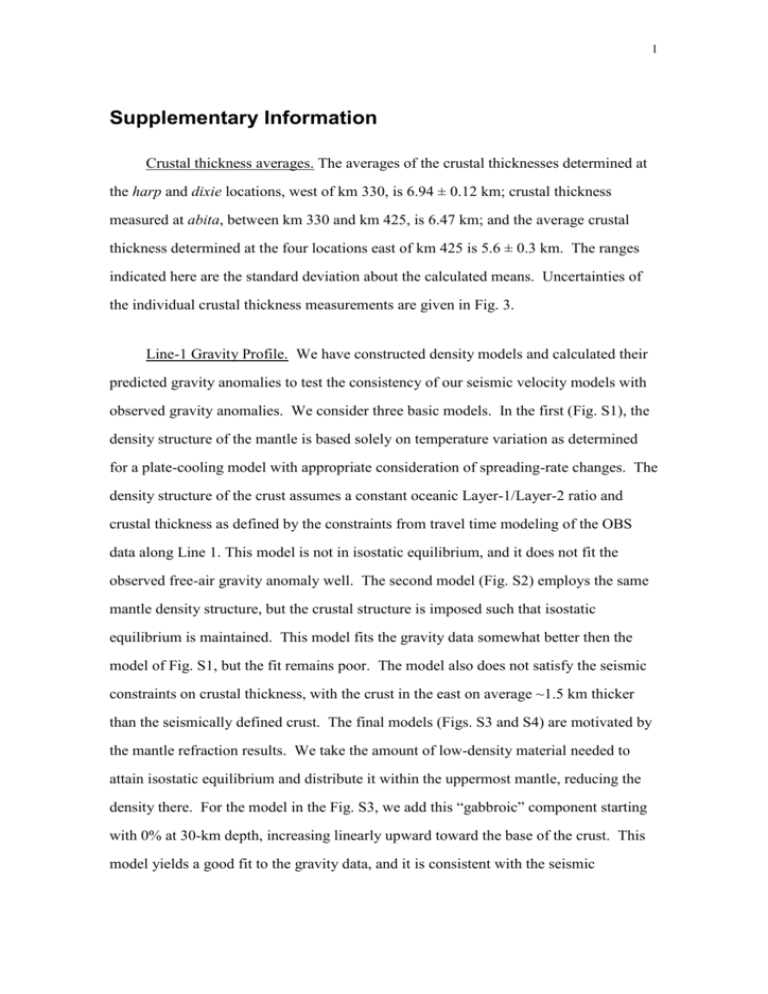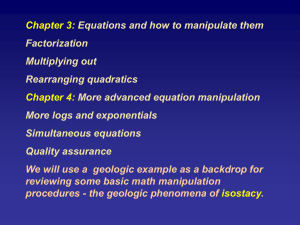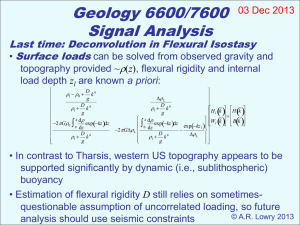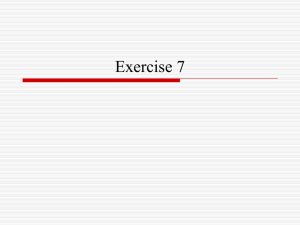Supplementary Information - Word file (40 KB )
advertisement

1 Supplementary Information Crustal thickness averages. The averages of the crustal thicknesses determined at the harp and dixie locations, west of km 330, is 6.94 ± 0.12 km; crustal thickness measured at abita, between km 330 and km 425, is 6.47 km; and the average crustal thickness determined at the four locations east of km 425 is 5.6 ± 0.3 km. The ranges indicated here are the standard deviation about the calculated means. Uncertainties of the individual crustal thickness measurements are given in Fig. 3. Line-1 Gravity Profile. We have constructed density models and calculated their predicted gravity anomalies to test the consistency of our seismic velocity models with observed gravity anomalies. We consider three basic models. In the first (Fig. S1), the density structure of the mantle is based solely on temperature variation as determined for a plate-cooling model with appropriate consideration of spreading-rate changes. The density structure of the crust assumes a constant oceanic Layer-1/Layer-2 ratio and crustal thickness as defined by the constraints from travel time modeling of the OBS data along Line 1. This model is not in isostatic equilibrium, and it does not fit the observed free-air gravity anomaly well. The second model (Fig. S2) employs the same mantle density structure, but the crustal structure is imposed such that isostatic equilibrium is maintained. This model fits the gravity data somewhat better then the model of Fig. S1, but the fit remains poor. The model also does not satisfy the seismic constraints on crustal thickness, with the crust in the east on average ~1.5 km thicker than the seismically defined crust. The final models (Figs. S3 and S4) are motivated by the mantle refraction results. We take the amount of low-density material needed to attain isostatic equilibrium and distribute it within the uppermost mantle, reducing the density there. For the model in the Fig. S3, we add this “gabbroic” component starting with 0% at 30-km depth, increasing linearly upward toward the base of the crust. This model yields a good fit to the gravity data, and it is consistent with the seismic 2 observations on crustal thickness, with isostacy, with the requirement for a positive velocity gradient in the upper mantle, and with our notion that this gradient is due to a retained gabbroic component. A model where the distribution of melt begins at 60-km depth (Fig. S4) fits the gravity somewhat better than the model of Fig. S3, but gabbroic material is likely to transform to eclogite within the 30- to 60-km depth range, and so the imposed crustal density of this added component is probably not physically plausible. We indicate the root-mean-square misfit of the various models in Fig. S5. In summary, we believe that the gravity results strengthen the notion that a gabbroic component retained in the upper mantle provides a plausible explanation for the large velocity gradients observed over the eastern portion of Line 1. Our preferred density model, Fig. S3, is based solely on the crustal thickness observations and a requirement of isostatic equilibrium. These requirements impart both positive velocity gradients in the east and a transition from positive to approximately zero velocity gradient near the location where the transition in mantle propagation properties is observed from the mantle refraction data. This model fits the observed gravity data better than an isostatically balanced lithosphere with uniform crustal thickness and mantle density. Conceptual model of melt retention. The spatial offset between the change in mantle seismic propagation properties (km 300) and the location of the spreading rate change from 13 mm/yr to 8 mm/yr is consistent with our conceptual model of melt retention. This model, illustrated in Figure S6, is based on the widely held notion that melt feeding crustal production at a mid-ocean ridge is drawn from the entire melting region, which extends more than 100 km off of the mid-ocean ridge axis [e.g. Spiegleman and Reynolds, 1999]. It is likely that a distributed, channelized melt network evolves as melt extraction proceeds, perhaps resembling an inverted fractal tree (Fig. S6a) [e.g. Spiegelman et al., 2001]. Disruption of this network due to the 3 thickening of the thermal lid is most likely to affect the upper channels that drain the off-axis portion of the network, trapping melt within that portion of the network (Fig. S6b). This trapped melt eventually crystallizes into the lithosphere as it moves farther off axis. In this scenario, the retention of off-axis melts, beginning at some point in time associated with a decrease in spreading rate, would necessarily be manifest underneath lithosphere of greater age than the spreading-rate change. We believe that this offset, illustrated in Fig. S6c, provides the explanation for the observed seismicpropagation/spreading-rate change offset along FAIM Line 1. An interesting corollary of this scenario is that the observed seismicpropagation/spreading-rate change offset provides some information on the width of the melt zone. This width is predicted to be 1.0-1.5 times the depth of melting for passiveflow spreading models and ~0.5 times for buoyancy-driven flow models [Spiegelman and Reynolds, 1999]. The observed offset of ~100 km therefore tends to favour passively driven flow and suggests a melt-zone thickness of 60-100 km, consistent with current thinking [Salters and Hart, 1989; Shen and Forsythe, 1995]. In addition, we note that the preferential retention of off-axis melts, as illustrated in Fig. S6, is the basis of our explanation for the widely observed correlation between thin oceanic crust and increased concentrations of incompatible elements, as described in the text of the paper. 4 Supplemental References Salters, V. J. M., & Hart, S. R. The hafnium paradox and the role of garnet in the source of mid-ocean ridge basalts, Nature, 342, 420-422, 1989. Shen, Y., & Forsyth, D.W. Geochemical constraints on initial and final depths of melting beneath mid-ocean ridges, J. Geophys. Res., 100, 2211-2237, 1995. Spiegelman, M., Kelemen, P. B., & Aharonov, E. Causes and consequences of flow organization during melt transport: The reaction infiltration instability in compactible media, J. Geophys. Res., 106, 2061-2077, 2001. 5 Supplemental Figure Captions Figure S1. bottom: Density model based on seismic constraints on crustal structure for crustal densities and plate cooling for mantle densities. Only the upper 100 km of this 200-km-deep model is shown. This model is not in isostatic equilibrium. The white line indicates the location of a smooth, isostatically balanced crust. Note that the difference between the Moho based on seismic constraints and the Moho of the isostatically balanced crust is ~1.5 km over the eastern portion of Line 1. top: Observed (black) and calculated (blue) free-air gravity anomaly. The fit of the model to the data is poor. Figure S2. bottom: As in Fig. S1, but now the model consists of an isostatically balanced crust. The white line indicates the seismically constrained Moho. top: The fit of the predicted response to the data is improved over the “seismic crust” model, but it is still poor. Figure S3. bottom: As in Fig. S1, but now the amount of low-density “crustal” (or melt derived) material needed to isostatically balance the lithosphere is distributed over the uppermost mantle, beginning with 0 added material at 30km depth and increasing the amount of added, low-density material linearly toward the Moho. top: The fit of the predicted response to the data is good. This model satisfies the seismic constraints on crustal thickness, it satisfies isostacy, is satisfies the gravity observations, and it is consistent with positive velocity gradients over the eastern portion of the model. Figure S4. bottom: As in Fig. S3, but now the amount of low-density material needed to isostatically balance the lithosphere is distributed from 60-km depth toward the Moho. top: The fit of the predicted response to the data is somewhat better than the “30-km” model, but a gabbroic phase below ~35-km depth would begin a transformation to eclogite and so this density structure is 6 difficult to reconcile with a simple addition of basaltic component due to incomplete melt extraction. Figure S5. bottom: Fits of the various density models to the observed anomaly. top: RMS misfit for the various density models. Misfit for the “seismic crust” model (Fig. S1) is not plotted, but is ~25 mGal. Figure S6. Conceptual model of increased melt retention accompanying a step decrease in spreading rate. a) Upwelling driven by separation of the lithosphere (dark grey) occurs over a broad region, and the extent of the melt zone (red) beneath an spreading centre is correspondingly large, 100 km or more. Melt extraction occurs though a distributed, channelized melt network that focuses melt from all portions of the melt zone to the ridge. Some melt is not incorporated into the network (yellow), and this melt eventually freezes into the lithosphere as gabbroic inclusions (blue). b) Thickening of the thermal lid due to a decrease in spreading rate (at triangle) is most likely to affect the upper network channels that drain the off-axis portion of the network, trapping melt in that area. c) This trapped melt eventually crystallizes into the lithosphere as it moves farther off axis. Retained melt is present underneath lithosphere of greater age than the spreading-rate change, with the offset between the occurrence of retained melt and the spreading rate change reflecting the halfwidth of the melt zone (horizontal line over triangle). This offset may provide the explanation for the observed seismic-propagation/spreading-rate change offset along FAIM Line 1. Also note in (c) that the melt which feeds the spreading centre originates from upwelling primarily beneath the spreading center. Figure S7. Analysis of amplitude versus offset (AVO) pattern for Tecate. black/dot) root-mean-square (RMS) amplitude for a 0.5-s window about the 7 mantle-refraction phase. red) 13-point (12 km) average of the Tecate RMS values. green) RMS amplitude within a 1-s window 1s prior to the first arriving energy, i.e. RMS amplitude of the stacked background noise. The step increase in noise at –325 km is related to a change from 3-fold stacking to 1fold. blue) predicted amplitude response for the continuous-gradient model (Fig. 3). heavy black) predicted amplitude response for the velocity-step model (Fig. 3). The velocity-step model predicts the amplitude decay beyond –250 km better than the continuous gradient model. However, the magnitude of anomalous (with respect to a 1D response) amplitude behaviour in the data between –125 km to –225 km exceeds the magnitude of the difference between the two predicted responses beyond –225 km, suggesting that inferences based on AVO should be viewed with caution. Further analyses of the amplitude response of the FAIM data are underway. Figure S8. FAIM profile 420 for offset –90 km to 90 km. The amplitudes, A, have been scaled by offset, X, so that Ascaled = A X. Figure S9. FAIM profile cass for offset –210 km to 0 km. The amplitudes have been scaled by offset. Figure S10. FAIM profile Tecate for offset –400 km to -200 km. The amplitudes have been scaled by offset. Figure S11. Model parameters and fit statistics for the crustal thickness and velocity measurements at each instrument-pair location. Seafloor and basement depth were constrained with multi-beam and multi-channel seismic data. A constant oceanic seismic Layer-2/Layer-3 ration was assumed and Layer-2 velocity structure was adjusted to satisfy refraction traveltimes. For each instrument, Layer-3 velocity and thickness were inverted for using a fourparameter model: velocity at the top and bottom of the layer, and Moho depth at 8 distances of 100 km on either side of the instrument. For each instrument, velocity at the top of Layer 3 was held fixed and the three remaining parameters were inverted for. In each panel, black dots represent the results of individual inversions for distinct values of the top Layer-3 velocity. These dots are plotted as a function of crustal thickness beneath the instrument and RMS error predicted for the inverted model. A well defined minimum with respect to crustal thickness exists for each instrument. The average Layer-3 velocity of the best fitting model is indicated (blue) for each instrument. This sensitivity analysis forms the basis of the error bars shown for crustal thickness in Fig. 4.









